
Do you have a question about the Toshiba RAS-3M23GACV-E and is the answer not in the manual?
| Brand | Toshiba |
|---|---|
| Model | RAS-3M23GACV-E |
| Category | Air Conditioner |
| Language | English |
Lists the remote controller unit as an accessory for the air conditioner.
Lists the remote controller holder as an accessory.
Lists the necessary batteries as an accessory.
Provides safety warnings related to the air conditioner's installation process.
General caution regarding safe disconnection of the appliance from the mains supply.
Details safety warnings to be observed during the operation of the air conditioner.
Offers safety warnings pertaining to the movement or repair of the air conditioner unit.
Offers further operational cautions on usage purposes and necessary ventilation.
Identifies the supply chamber component of the indoor air conditioning unit.
Identifies the duct component used for connecting air conditioning units.
Identifies the indoor unit of the air conditioning system.
Identifies the supply air grille component of the air conditioner.
Identifies the return grille component of the air conditioner.
Identifies the air filter component within the air conditioning system.
Identifies the signal receiving section on the main unit of the air conditioner.
Identifies the signal transmitting section of the remote controller.
Identifies the outdoor unit of the air conditioning system.
Identifies the air inlet ports on the side and rear of the outdoor unit.
Identifies the air outlet port on the outdoor unit.
Identifies the remote control device for the air conditioner.
Identifies the piping and electrical wiring connections.
Explains the function and use of the temporary operation switch on the unit.
Details the procedure for setting the appropriate operating voltage for the unit.
Describes the function of the START/STOP button to initiate or cease operation.
Details the function of the MODE button for selecting operating modes.
Explains the function of the temperature adjustment buttons (up/down).
Describes the function of the FAN button for controlling fan speed.
Explains the function of the OFF timer button for scheduling shutdowns.
Details the function of the ON timer button for scheduling start-ups.
Explains the function of the SET button for confirming timer settings.
Describes the function of the CLR button to cancel timer operations.
Explains the function of the Hi-POWER button for enhanced operation.
Details the function of the MEMO button for saving frequently used settings.
Explains the function of the ECO timer button for energy-saving operation.
Describes the function of the PRESET button for recalling memorized settings.
Explains the function of the TIMER button for clock and timer adjustments.
Details the function of the AUTO button for automatic mode selection.
Explains the indicator that shows the remote controller is transmitting signals.
Describes the indicators on the remote display for current operation modes.
Explains the display on the remote showing the set operating temperature.
Describes the indicators on the remote for selected fan speed levels.
Explains the remote display indicators for timer settings and current time.
Explains the indicator that shows when High Power operation is active.
Explains the indicator that shows when settings are being memorized.
Explains the indicator that shows when the ECO TIMER is in operation.
Explains how to change the remote controller's setting from A to B.
Provides step-by-step instructions for loading batteries into the remote controller.
Offers information regarding battery replacement and proper care.
Details the procedure for setting the current time on the remote controller's clock.
Describes the initial clock display status after inserting new batteries.
Outlines the steps required to adjust the clock time on the remote controller.
Provides guidance on optimal placement of the remote for effective signal reception.
Offers instructions on how to properly install the remote controller holder.
Explains the procedure for attaching and detaching the remote from its holder.
Steps required to initiate the automatic operation mode of the air conditioner.
Steps required to cease the automatic operation mode of the air conditioner.
Steps required to initiate the auto changeover operation mode.
Steps required to cease the auto changeover operation mode.
Steps to start cooling, heating, or fan-only operation modes.
Steps to stop cooling, heating, or fan-only operation modes.
Steps required to initiate the dry operation mode.
Steps required to cease the dry operation mode.
Instructions on how to activate the High Power operation mode for rapid cooling/heating.
Instructions on how to deactivate the High Power operation mode.
Instructions for setting both ON and OFF timers for the air conditioner.
Detailed steps for setting desired timer durations and times.
Setting sequence for stopping operation after sleep and resuming on wake-up.
Setting sequence for starting operation upon waking and stopping before leaving.
Instructions for setting a combined timer that repeats its schedule daily.
Procedure for cancelling any previously set timer operations.
How to use the MEMO button to save frequently used operating settings.
How to recall and activate settings previously saved using the MEMO button.
Step-by-step instructions for enabling the auto restart function.
Step-by-step instructions for disabling the auto restart function.
Explanation of how the unit automatically selects cooling, heating, or fan modes.
Details on how the High Power mode functions to quickly adjust room temperature.
Explanation of the ECO timer's behavior to conserve energy during operation.
Advice on maintaining an optimal and comfortable room temperature setting.
Information on the importance and frequency of cleaning air filters for performance.
Tips on managing doors and windows to maintain efficient room climate control.
Guidance on using curtains effectively for cooling and heating efficiency.
Encouragement to utilize the timer function for optimal operating schedules.
Advice on adjusting airflow direction for even air distribution within the room.
Instructions and precautions for cleaning the air conditioner's remote controller.
Steps to prepare the air conditioner unit for periods of non-use exceeding one month.
Verification step to ensure air filters are correctly installed before operation.
Verification to ensure air outlets and inlets are free from obstructions.
Ensuring batteries are correctly loaded in the remote controller.
Procedure for turning on the main power supply to the air conditioner unit.
Steps to prepare for cleaning the return grille, including turning off the unit.
Detailed instructions for cleaning the return grille using water and detergent.
Guidance on the recommended frequency for cleaning the air filters.
Steps to prepare for cleaning the air filters, including unit shutdown.
Instructions on cleaning air filters using vacuum or water washing.
Explanation of the 3-minute delay function preventing immediate restarts after power activation.
Describes how the unit behaves and restarts after a power interruption.
Explains operational priority when different modes are selected in multiple rooms.
Details on preheating, warm air control, and defrosting during heating operations.
Specifies recommended outdoor/indoor temperatures and humidity levels for operation.
Critical safety warnings regarding installation.
Lists specific locations and environments where the unit should not be installed.
Guidance on minimizing noise and vibration issues during installation.
General caution and initial steps for addressing common air conditioner problems.
Checks for when the unit is not working.
Checks for poor cooling or heating performance.
Investigating unusual noises from the units.
Addressing smells from the unit.
Understanding the flashing operation lamp.
Explaining sounds from inactive indoor units.
Information about outdoor unit frosting and defrosting.
Reasons for unexpected airflow changes.
Explaining white mist from the outdoor unit.
Troubleshooting fan speed not changing.
Troubleshooting signal transmission issues.
Troubleshooting when the remote display is off.
Troubleshooting display disappearing over time.
Troubleshooting lack of receiving sounds.

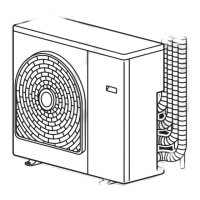



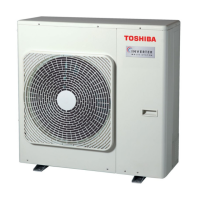

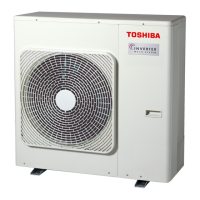
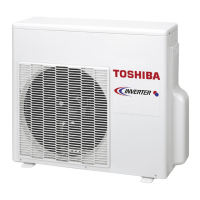
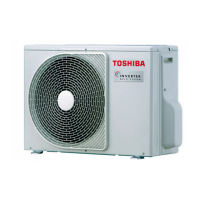


